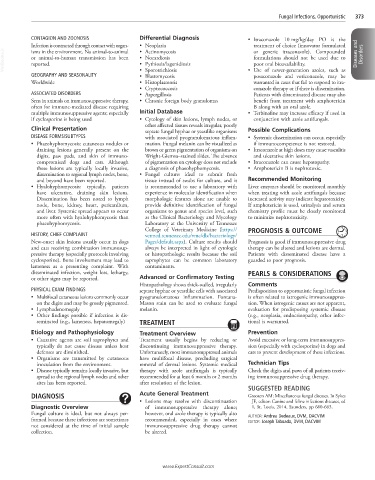Page 786 - Cote clinical veterinary advisor dogs and cats 4th
P. 786
Fungal Infections, Opportunistic 373
CONTAGION AND ZOONOSIS Differential Diagnosis • Itraconazole 10 mg/kg/day PO is the
Infection is contracted through contact with organ- • Neoplasia treatment of choice (innovator formulated
VetBooks.ir or animal-to-human transmission has been • Nocardiosis formulations should not be used due to Diseases and Disorders
• Actinomycosis
or generic itraconazole). Compounded
isms in the environment. No animal-to-animal
• Pythiosis/lagenidiosis
reported.
poor oral bioavailability.
GEOGRAPHY AND SEASONALITY • Sporotrichiosis • Use of newer-generation azoles, such as
posaconazole and voriconazole, may be
• Blastomycosis
Worldwide • Histoplasmosis warranted in cases that fail to respond to itra-
• Cryptococcosis conazole therapy or if there is dissemination.
ASSOCIATED DISORDERS • Aspergillosis Patients with disseminated disease may also
Seen in animals on immunosuppressive therapy, • Chronic foreign body granulomas benefit from treatment with amphotericin
often for immune-mediated disease requiring B along with an oral azole.
multiple immunosuppressive agents; especially Initial Database • Terbinafine may increase efficacy if used in
if cyclosporine is being used • Cytology of skin lesions, lymph nodes, or conjunction with azole antifungals.
other affected tissues reveals irregular, poorly
Clinical Presentation septate fungal hyphae or yeastlike organisms Possible Complications
DISEASE FORMS/SUBTYPES with associated pyogranulomatous inflam- • Systemic dissemination can occur, especially
• Phaeohyphomycosis: cutaneous nodules or mation. Fungal melanin can be visualized as if immunocompetence is not restored.
draining lesions generally present on the brown or green pigmentation of organisms on • Itraconazole at high doses may cause vasculitis
digits, paw pads, and skin of immuno- Wright-Giemsa–stained slides. The absence and ulcerative skin lesions.
compromised dogs and cats. Although of pigmentation on cytology does not exclude • Itraconazole can cause hepatopathy.
these lesions are typically locally invasive, a diagnosis of phaeohyphomycosis. • Amphotericin B is nephrotoxic.
dissemination to regional lymph nodes, bone, • Fungal culture: ideal to submit fresh
and beyond have been reported. tissue instead of swabs for culture, and it Recommended Monitoring
• Hyalohyphomycosis: typically, patients is recommended to use a laboratory with Liver enzymes should be monitored monthly
have ulcerative, draining skin lesions. experience in molecular identification when when treating with azole antifungals because
Dissemination has been noted to lymph morphologic features alone are unable to increased activity may indicate hepatotoxicity.
node, bone, kidney, heart, pericardium, provide definitive identification of fungal If amphotericin is used, urinalysis and serum
and liver. Systemic spread appears to occur organisms to genus and species level, such chemistry profile must be closely monitored
more often with hyalohyphomycosis than as the Clinical Bacteriology and Mycology to minimize nephrotoxicity.
phaeohyphomycosis. Laboratory at the University of Tennessee
College of Veterinary Medicine (https:// PROGNOSIS & OUTCOME
HISTORY, CHIEF COMPLAINT vetmed.tennessee.edu/vmc/dls/bacteriology/
New-onset skin lesions usually occur in dogs Pages/default.aspx). Culture results should Prognosis is good if immunosuppressive drug
and cats receiving combination immunosup- always be interpreted in light of cytologic therapy can be altered and lesions are dermal.
pressive therapy (especially protocols involving or histopathologic results because the soil Patients with disseminated disease have a
cyclosporine). Bone involvement may lead to saprophytes can be common laboratory guarded to poor prognosis.
lameness as a presenting complaint. With contaminants.
disseminated infection, weight loss, lethargy, PEARLS & CONSIDERATIONS
or other signs may be reported. Advanced or Confirmatory Testing
Histopathology shows thick-walled, irregularly Comments
PHYSICAL EXAM FINDINGS septate hyphae or yeastlike cells with associated Predisposition to opportunistic fungal infection
• Multifocal cutaneous lesions commonly occur pyogranulomatous inflammation. Fontana- is often related to iatrogenic immunosuppres-
on the digits and may be grossly pigmented. Mason stain can be used to evaluate fungal sion. When iatrogenic causes are not apparent,
• Lymphadenomegaly melanin. evaluation for predisposing systemic disease
• Other findings possible if infection is dis- (e.g., neoplasia, endocrinopathy, other infec-
seminated (e.g., lameness, hepatomegaly) TREATMENT tions) is warranted.
Etiology and Pathophysiology Treatment Overview Prevention
• Causative agents are soil saprophytes and Treatment usually begins by reducing or Avoid excessive or long-term immunosuppres-
typically do not cause disease unless host discontinuing immunosuppressive therapy. sion (especially with cyclosporine) in dogs and
defenses are diminished. Unfortunately, most immunosuppressed animals cats to prevent development of these infections.
• Organisms are transmitted by cutaneous have multifocal disease, precluding surgical
inoculation from the environment. removal of dermal lesions. Systemic medical Technician Tips
• Disease typically remains locally invasive, but therapy with azole antifungals is typically Check the digits and paws of all patients receiv-
spread to the regional lymph nodes and other recommended for at least 6 months or 2 months ing immunosuppressive drug therapy.
sites has been reported. after resolution of the lesion.
SUGGESTED READING
DIAGNOSIS Acute General Treatment Grooters AM: Miscellaneous fungal diseases. In Sykes
• Lesions may resolve with discontinuation JE, editor: Canine and feline infectious diseases, ed
Diagnostic Overview of immunosuppressive therapy alone; 1, St. Louis, 2014, Saunders, pp 660-663.
Fungal culture is ideal, but not always per- however, oral azole therapy is typically also AUTHOR: Andrea Dedeaux, DVM, DACVIM
formed because these infections are sometimes recommended, especially in cases where EDITOR: Joseph Taboada, DVM, DACVIM
not considered at the time of initial sample immunosuppressive drug therapy cannot
collection. be altered.
www.ExpertConsult.com

